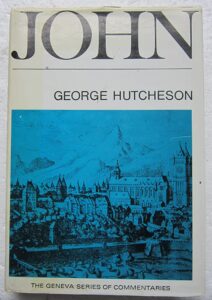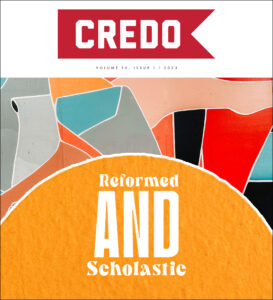O ne of the reasons I frequent used bookstores is the promise of hidden treasure. Buried beneath stacks of tottering books with faded covers can lie treasure of immeasurable value—gems forgotten by the passage of time. To discover that gem is like knowing a delicious secret before anyone else. I found that secret gem one morning when I stumbled upon The Exposition of the Gospel according to John by the Scottish Covenanter, George Hutcheson.
ne of the reasons I frequent used bookstores is the promise of hidden treasure. Buried beneath stacks of tottering books with faded covers can lie treasure of immeasurable value—gems forgotten by the passage of time. To discover that gem is like knowing a delicious secret before anyone else. I found that secret gem one morning when I stumbled upon The Exposition of the Gospel according to John by the Scottish Covenanter, George Hutcheson.
Hutcheson’s work contains all the hallmarks of robust Puritanism—doctrinal precision with heartwarming devotion to Christ. It is no wonder, then, that Hutcheson was one of Charles Spurgeon’s favorites. Hutcheson’s commentary on John was Spurgeon’s favorite to consult. He said of it, “Excellent; beyond all praise. It is a full-stored treasury of sound theology, holy thought, and marrowy doctrine.”1
For many today, however, George Hutcheson remains a stranger. Hutcheson (1615-1674) was a Church of Scotland minister, biblical commentator, and key figure in the events involving the Scottish Covenanters. He was educated at the University of Edinburgh (MA, 1638) and pastored in the villages of Colmonell and Irvine in the county of Ayrshire. He was close friends with David Dickson, another prominent Scottish Covenanting minister, biblical commentator, and Principal of the University of Glasgow. Hutcheson wrote other commentaries, such as A Brief Exposition of the Twelve Minor Prophets (1653-5), An Exposition of the Book of Job (1669), and more.2
Overview of Work
The Exposition of the Gospel according to John (1657) originated from Hutcheson’s preaching notes on the Gospel of John, likely from sermons preached at Colmonell, Ayrshire. Hutcheson explains in the introduction how he prioritized writing this commentary after he was faced with his mortality from some unknown incident. In the shadow of his own finitude, Hutcheson wrote this work to point to the infinite Son of God, who is “the fountain and preserver of life in living creatures” and who “hath undertaken to work the work of redemption of sinners, and so hath engaged himself to carry it through” (12, 84).
Spurgeon’s description of Hutcheson as a “full-stored treasury of sound theology” is certainly apt. Share on XThe commentary is a mid-sized volume of 439 pages. However, due to the density of the exposition and Hutcheson’s ability to make every word count, it feels more thorough and comprehensive than the largest contemporary tomes on John. The structure of the commentary is a combination of explanation and application. Hutcheson walks through the entire Gospel verse-by- verse. He first explains each verse and how it relates to the overall scheme of John’s narrative. Then, he has a section labeled “Doctrines,” which is a numbered list of various systematic doctrines and practical applications of the verse.
The explanations of the verses are clear and useful, but what makes this commentary stand out is the depth of doctrinal clarity and the breadth of application after each verse. Hutcheson combines lucid dogmatic explanation with sensitive pastoral application. For example, consider how in the space of a brief paragraph Hutcheson goes from elucidating the unity of the divine essence and the distinction of the persons in the Godhead, to redemptive-covenantal language, to an encouragement for believers to trust in Christ because of his nature and offices:
“The Son’s coexistence with the Father is also a matter seriously to be considered by believers, wherein they may see the deep wisdom and rich love of God, who hath found a way of reconciliation of lost man by the same in nature and essence who is the party offended, and that the unity of the divine essence and the distinction of persons should contribute to make the redemption and reconciliation of lost man effectual by him; wherein also believers, who have fled to Christ for refuge, may not only find him to be true God, able to supply all wants, and to save to the uttermost, but may also find the Father in the Mediator, as being one in essence with him.” (11).
Hutcheson and Reformed Orthodoxy
Spurgeon’s description of Hutcheson as a “full-stored treasury of sound theology” is certainly apt. Hutcheson’s exposition is a theologically sound distillation of the basic tenets of Reformed orthodoxy. His exegesis is doctrinal and biblical; his understanding of the Trinity and Christology is classical and conciliar; and his articulation of soteriology is set within the broader framework of covenant theology. Not only is the content of Hutcheson’s exposition markedly Reformed, but his method of exposition is reflective of earlier theologians, such as the sixteenth-century Reformed scholastic theologian, Girolamo Zanchi. R. A. Muller notes, Hutcheson’s style of adding “a series of doctrinal loci at the end of the exposition of each pericope” is similar to Girolamo Zanchi.3His exegesis is doctrinal and biblical; his understanding of the Trinity and Christology is classical and conciliar; and his articulation of soteriology is set within the broader framework of covenant theology. Share on X
First and foremost, Hutcheson’s exposition is doctrinal exegesis. His ability to articulate complex doctrinal truths with precision and clarity is rooted in the confessionalism developed during the period of early orthodoxy. His strong dogmatic emphasis also could be the result of his education at Edinburgh, since, as Carl Trueman notes, the four ancient Scottish universities were directly tied to the Church of Scotland so that there was a steady “Presbyterian emphasis on the role of dogmatics in ministerial preparation.”4Yet, standing underneath and within this doctrinal exegesis is careful textual analysis characteristic of the first- and second-generation Reformers. For example, when commenting on John 1:1, Hutcheson notes the lack of article for the predicate nominative “θεὸς” in the clause “καὶ θεὸς ἦν ὁ λόγος” is to be taken in a qualitative sense, namely that the Logos was divine. He explains how this distinction proves the Son and Father share one divine essence but are different persons. He writes, “…signifying that as the Son is a distinct person from the Father, so he is one God with him, in the same indivisible nature and essence, communicated unto him from the Father, and with him to the Holy Spirit, so that their name, nature, properties, glory, and working, are one” (10). Hutcheson’s exegesis is thoroughly biblical, but it is not biblicist. His command of the Scriptures appears effortless. Like other writers in the Great Tradition, Hutcheson strongly believes in the divine inspiration of Scripture, the unity of the canon, and the continuity of the covenants and feels the hermeneutical freedom to cite other parts of Scripture to explain and articulate John’s fuller point, as well as resolve complex tensions within the gospel.5 Hutcheson’s exegesis is thoroughly biblical, but it is not biblicist. Share on X
Second, Hutcheson’s grasp of the Trinity and Christology is clear, concise, and classical. Hutcheson uses classical terminology when speaking of the Godhead found widely in patristic, scholastic, and Reformed usage—“co-eternal,” “co-essential,” “con-substantial,” “essence,” “nature,” “subsistence,” etc.
Hutcheson is insistent on the full equality and unity of the Son with the Father, meaning there is no subordination between the Father and Son within the Godhead. The Son is Son because of generation, not subordination. He says, “Christ, in working with the Father, acts not as an instrument subordinate, but, as there is a unity in the work, so also in the manner of it, by the same power, wisdom, liberty, authority, etc.” (79). He is careful to show how the Son being sent by the Father does not imply subordination. He writes, “Christ’s condescendence to come into the world as Mediator of sinners diminisheth nothing of his divine glory…for though he be ‘sent,’ yet he is to be honoured ‘even as the Father.’ He is not an ambassador, whose honour ceaseth by the presence of the king, but remaineth equal with the Father, though in respect of that voluntary dispensation, as God-man, he is inferior.” (82). Hutcheson’s shares a participatory framework of creation with other notable Johannine commentators such as Cyril of Alexandria, Augustine, and Aquinas. Share on XHutcheson is one of the clearest Johannine commentators I have seen on inseparable operations of the Trinity within John. He notes that because the Father and Son are one in nature and essence, so they are “undivided and inseparable in operation and working” (79). Christ is “joint with the Father, not in one or some only of his works, but in all that he doeth” (ibid).
Hutcheson’s shares a participatory framework of creation with other notable Johannine commentators such as Cyril of Alexandria, Augustine, and Aquinas. All created things receive life because they participate in the life of the Son, who is the “fountain and preserver” of all life (12). All creatures that live “have and hold their life of him [Christ], not as an instrument, but as the fountain from when their life floweth and is preserved” (ibid). Like Cyril, Hutcheson is careful to distinguish that creatures participate in the life of God, but Christ is “light by nature and of himself” (14). Thus, he is life and light by nature, not by participation.
Hutcheson’s grasp of the Trinity and Christology is clear, concise, and classical. Share on XBecause all creatures participate in the life and light of the Logos, all mankind has a sense of the light that comes from God by nature. However, man has fallen from that life and light by the darkness accompanied by the fall. Thus, Hutcheson affirms the testimony of God in the “book of creation” but “such is the power of darkness in man’s nature that all who are left to these means do not receive that light so as to let it shine through them to direct their actions…nor do they take up that light which they have and use to be from God, but become proud of it as if it were their own” (13).
Third, Hutcheson’s understanding of salvation and the work of Christ is placed within the broader framework of his covenant theology. The substructure of covenant theology upholding his exposition of the work of Christ is a distinctive feature of the high orthodoxy of Hutcheson’s time. Hutcheson mentions the covenant of grace, covenant of works, and the covenant of redemption throughout. He speaks of Christ as every Christian’s “surety by the covenant of redemption” (321). Mankind is only saved by Christ in the covenant of grace. This covenant of grace was made known even to those before Christ’s incarnation, “so men were made participant of him and his benefits by faith” (182). This reflects chapter 8 of the Westminster Confession of Faith that “although the work of redemption was not actually wrought by Christ till after His incarnation, yet the virtue, efficacy, and benefits thereof were communicated into the elect, in all ages successively from the beginning of the world.” Jesus’s work of salvation, according to Hutcheson, is to “redeem” and “take charge of” the elect given to him by the Father in the covenant of redemption (353). Jesus is the Head of Believers, who will one day bring his church into the glory and happiness of heaven, where they will “be completely happy in a sight of Christ’s glory…when he shall be conspicuously glorified and admired in his saints…and when, all veils being laid aside, and they fitted for a more full fruition, shall visibly and immediately behold and enjoy him” (370).
One of the great Reformed orthodox commentaries
Though it has been forgotten, Hutcheson’s exposition of John is not only one of the great Reformed orthodox commentaries, but it is one of the greatest commentaries on John in the Great Tradition. It belongs on the same shelf as Cyril of Alexandria, Theodore of Mopsuestia, Cyril of Alexandria, Augustine, Aquinas, and Calvin.
Hutcheson has ruined modern John commentaries for me. Hutcheson is fresh whereas modern academia is stale. Share on XHutcheson has ruined modern John commentaries for me. I understand modern academic commentaries have different interests, conversation partners, and goals than Hutcheson. Yet, I cannot help but think that Hutcheson is fresh whereas modern academia is stale. Many Johannine tomes are more concerned with rethinking Christology rather than relishing in the old paths, more concerned with literary critique than looking at Jesus, more concerned with hypothesized compositional layers than the coming of the God-man to save sinners. Hutcheson’s aim in writing this commentary ought to be the aim of every biblical commentator— “to do service to the church of Christ in my generation, and to contribute my endeavours for promoting that public design of making the holy scriptures yet more clear unto the Lord’s people” (8).
Hutcheson is treasure buried beneath the sand dunes of church history. Reader, go and sell all you possess to buy the field containing hidden treasure, for you will indeed discover there a “full-stored treasury of sound theology, holy thought, and marrowy doctrine.”
Endnotes


